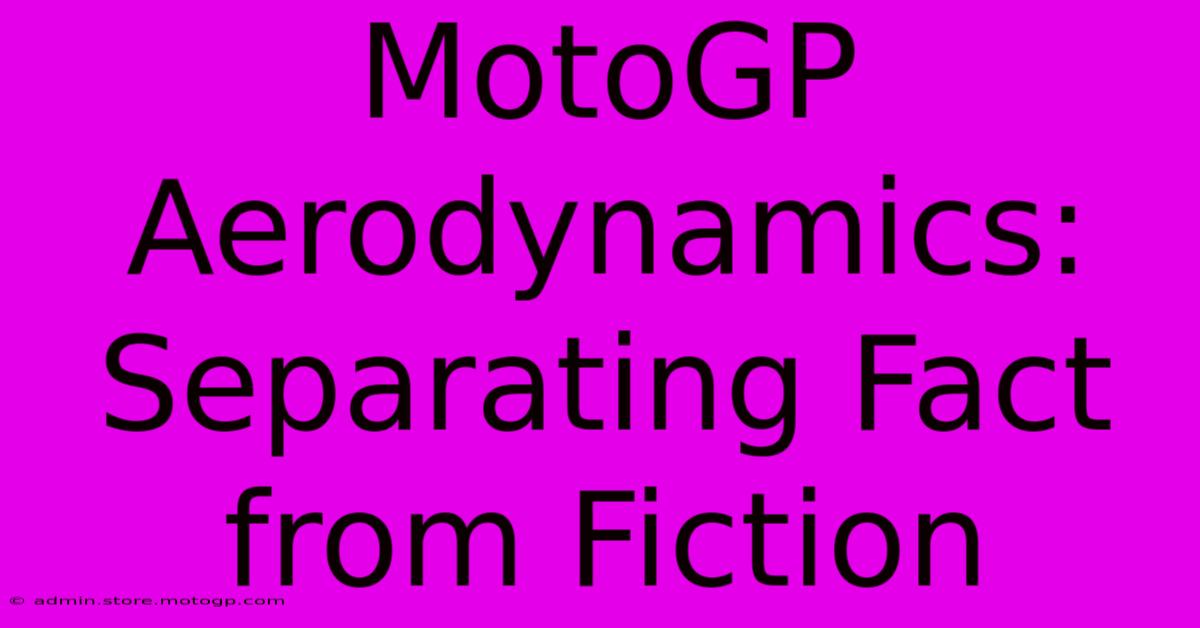MotoGP Aerodynamics: Separating Fact From Fiction

Table of Contents
MotoGP Aerodynamics: Separating Fact from Fiction
MotoGP racing is a relentless pursuit of speed, and aerodynamics play a crucial role in achieving that ultimate velocity. While the visual spectacle of winglets and aerodynamic devices is undeniable, understanding the real impact of these advancements requires separating fact from fiction. This article delves into the science behind MotoGP aerodynamics, debunking common myths and highlighting the true effect of these sophisticated systems on race performance.
The Science of Speed: How Aerodynamics Impact MotoGP
The physics of MotoGP aerodynamics are complex, but the core principle is simple: managing airflow to maximize downforce and minimize drag.
-
Downforce: This force pushes the bike towards the track, improving traction and allowing riders to corner faster and brake later. It's essential for stability at high speeds.
-
Drag: This force opposes the bike's motion, slowing it down. Minimizing drag is crucial for achieving top speed on straights.
The delicate balance between these two forces is the key to a competitive machine. Engineers constantly strive to optimize this balance, employing sophisticated computational fluid dynamics (CFD) and wind tunnel testing.
The Role of Winglets and Aerodynamic Devices
The prominent winglets and aerodynamic appendages on modern MotoGP bikes aren't just for show. They're carefully designed to manipulate airflow, generating downforce and reducing drag in specific areas.
-
Front Winglets: These generate downforce at the front, improving stability under braking and cornering. They also help stabilize the front end at high speeds, preventing wheelies.
-
Rear Winglets and Fairings: These manage airflow around the rear wheel and reduce drag, while also contributing to downforce. Their design often influences wheel lift and stability during acceleration.
-
Underbody Aerodynamics: This often overlooked area plays a significant role. Smooth underbody design minimizes turbulence and maximizes airflow efficiency. This is often as important, if not more important than, the visible external components.
Debunking Common Myths About MotoGP Aerodynamics
Despite the scientific basis, several misconceptions surround MotoGP aerodynamics:
Myth 1: More Winglets = More Downforce: While winglets contribute to downforce, adding more doesn't automatically translate to better performance. Beyond a certain point, additional winglets can create more drag and turbulence, negating any performance gains. It’s about optimization, not maximization.
Myth 2: Aerodynamics are the Sole Determinant of Performance: Aerodynamics are crucial, but they're only one piece of the puzzle. Engine power, chassis setup, rider skill, and tire performance all play equally significant roles in overall race performance. It's a holistic system where improvements in one area can offset weaknesses in another.
Myth 3: All Aerodynamic Solutions are Created Equal: Different manufacturers employ varying design philosophies and approaches. What works well for one team may not be optimal for another, depending on the specific characteristics of their bike and rider preferences. The best aerodynamic solution is highly specific to the overall package.
The Future of MotoGP Aerodynamics
The quest for aerodynamic advantage is ongoing. Expect to see continued refinement of existing designs and the exploration of even more innovative solutions in the future. This constant evolution ensures that MotoGP remains at the cutting edge of motorsport technology. The interplay between regulations and technological advancements will continue to shape the future of MotoGP aerodynamics. We'll likely see even more sophisticated solutions implemented as the sport continues its quest for speed and performance. Understanding the underlying principles, however, is crucial to appreciate the subtle nuances and strategic decisions that go into building a winning machine.

Thank you for visiting our website wich cover about MotoGP Aerodynamics: Separating Fact From Fiction. We hope the information provided has been useful to you. Feel free to contact us if you have any questions or need further assistance. See you next time and dont miss to bookmark.
Featured Posts
-
Breaking Down The Barriers F1 Vs Moto Gp Safety
Feb 19, 2025
-
Cotas Thrill Ride Open Track Days
Feb 19, 2025
-
F1 Concert An Epic Night Of Music And Motors
Feb 19, 2025
-
Moto Gps Most Exciting Overtakes Breathtaking Maneuvers
Feb 19, 2025
-
Moto Gp Top Speed A Glimpse Into The Future
Feb 19, 2025
